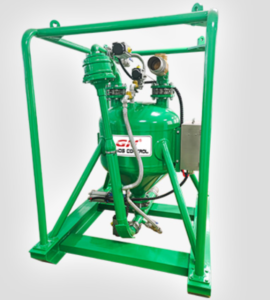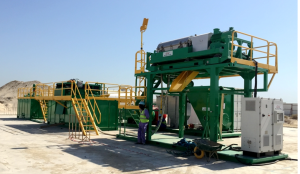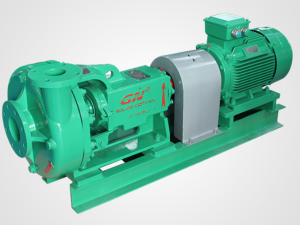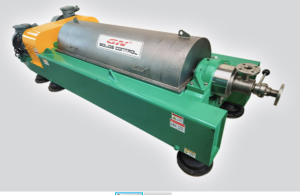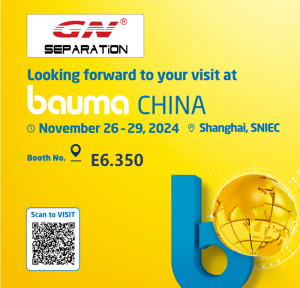Introduction
In industries requiring efficient transfer of solids, sludge, slurry, or powders, GN Separation’s GN Solids Vacuum Pump (also called sludge vacuum pump) stands out as a compact, robust, and versatile solution. Fully powered by compressed air, it offers an efficient and reliable method for material transfer without the need for electricity, making it ideal for a variety of challenging applications, including hazardous and explosion-proof environments.
What is GN Solids Vacuum Pump?
The GN Solids Vacuum Pump is a vacuum-loading solids transfer pump powered entirely by compressed air. It works by creating a high vacuum of 25″hg (85Kpa) to suction materials and uses positive pressure to discharge them. This pump can transfer materials over 500 meters, making it an ideal solution for long-distance operations.
Available in three models—GNSP-10B, GNSP-20B, and GNSP-40B—the GN Solids Vacuum Pump can handle flow rates ranging from 10 m³/h to 40 m³/h. GN can also design Group Pump Units on a single skid for higher flowrate requirements.
Key Features of GN Solids Vacuum Pump
- Fully Air-Powered
- Requires no electricity—powered solely by compressed air.
- Safe for explosive or hazardous environments such as oil, gas, and coal industries.
- High Performance and Versatility
- Handles solids content up to 80% and maximum solid sizes of up to 75mm.
- Capable of transferring materials over distances of up to 1000 meters (GNSP-40B).
- Suitable for sludge, slurry, powder, and other challenging materials.
- Compact and Robust Design
- Portable, lightweight models are available for easy transportation and operation.
- Durable construction ensures reliable performance in tough industrial environments.
- Automatic and Manual Operation
- Large pumps like GNSP-40B can operate in manual or automatic mode.
- Smaller pumps, including GNSP-10B and GNSP-20B, operate automatically.
GN Solids Vacuum Pump Applications
GN Solids Vacuum Pumps are widely used across industries for various demanding applications, including:
- Mining & Industrial Applications
- Coal and mining slurry transfer
- Tailings and ash pond cleaning
- Thickener de-sludge and shaft cleaning
- Oil & Gas Industry
- Drilling cuttings and OBM transfer
- Oil spill capture and hazardous waste recovery
- Construction & Tunneling
- TBM tunneling and sump cleaning
- Dam desilting and mud transfer
- Waste Management
- Effluent and waste processing transfer
- Petrochemical tank cleaning
- Agriculture & Food Industry
- Agricultural product and waste transfer
- Bulk powder (sand, cement, bentonite) transfer
From industrial clean-ups to bulk material handling, GN Solids Vacuum Pumps are trusted solutions for high-volume and challenging material transfer.
Working Principle of GN Solids Vacuum Pump
The pump operates in a two-phase cycle using compressed air:
- Vacuum Phase:
Compressed air creates a high vacuum inside the pump tank, which suctions material into the tank through the suction line. - Discharge Phase:
The valve switches to introduce positive air pressure, pushing the material out through the discharge line.
This simple yet highly effective mechanism ensures continuous and reliable operation.
Model Specifications
| Model | GNSP-40B | GNSP-20B | GNSP-10B |
|---|---|---|---|
| Max Capacity (m³/h) | 40 m³/h | 20 m³/h | 10 m³/h |
| Inlet/Outlet Size | 4” (114mm) | 4” (114mm) | 3” (89mm) |
| Vacuum Degree | 85Kpa / 25”hg | 85Kpa / 25”hg | 85Kpa / 25”hg |
| Max Suction Distance | 50 m | 50 m | 50 m |
| Max Discharge Distance | 1000 m | 500 m | 500 m |
| Max Solids Content | 80% Solids | 80% Solids | 80% Solids |
| Max Solids Size | 75 mm | 50 mm | 50 mm |
| Air Demand | 17 m³/min | 8 m³/min | 4.3 m³/min |
| Weight (kg) | 892 kg | 386 kg | 320 kg |
Note: Group Pump Units with combinations of 2 or 4 vacuum pumps are available for higher flowrates.
Why Choose GN Solids Vacuum Pump?
- No Electrical Requirements: Safe and ideal for hazardous zones.
- Highly Versatile: Handles a wide variety of materials and applications.
- Proven Efficiency: Long-distance transfer capabilities with minimal maintenance.
- Custom Solutions: Group Pump Units designed for large-scale operations.
Conclusion
The GN Solids Vacuum Pump is a reliable and efficient solution for challenging material transfer tasks across multiple industries. Its robust design, versatile applications, and compressed air operation make it an ideal choice for sludge, slurry, and solids handling.
For more information, Request a Quote or Download the Brochure to discover how GN Solids Vacuum Pumps can meet your operational needs.
GN Separation looks forward to working with you!
